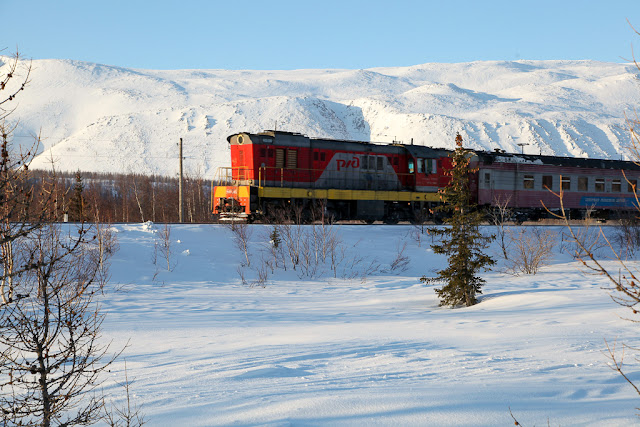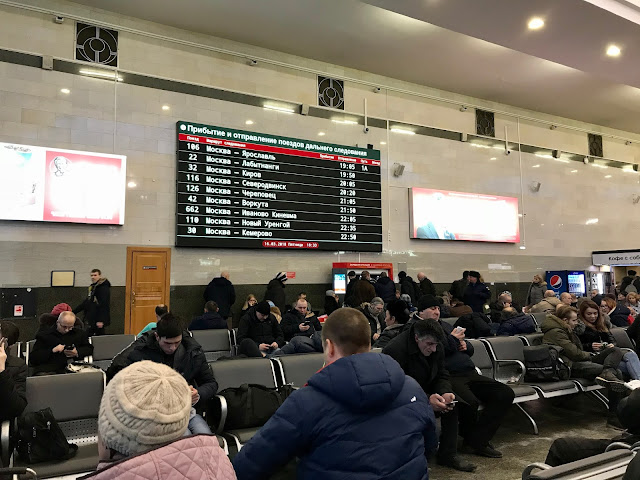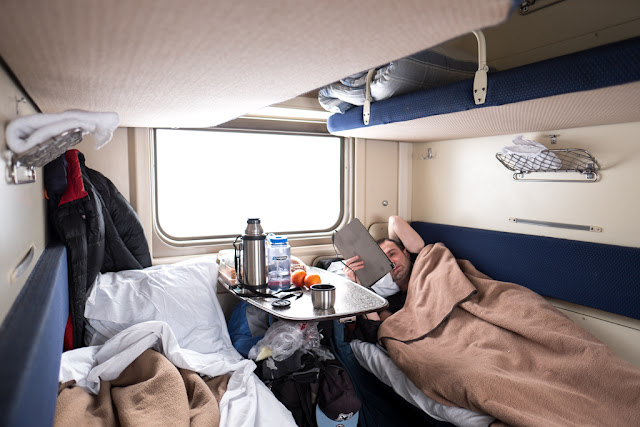When you think of ‘the End of the Earth’, presumably Antarctica, Greenland, or one of the famous capes of our planet spring to mind. And similarly, when you think of the train journey in Russia, the legendary Trans-Siberian comes to mind first—exactly what I had in mind when I decided to cross Russia coast to coast all the way from St. Petersburg to Sakhalin, and onto Japan. Ever heard of Trans-Polar train named Polar Arrow?
I absolutely had no idea that Russia has an extensive railroad network to practically all parts of the country, until a Russian colleague of mine, Andrei, mentioned the possibility of taking the train from Moscow to Salekhard, seeing the northern lights, and attending the indigenous Reindeer Herders Festival in the Siberian Arctic Circle. Quick research later, failed to find any mention of Salekhard in guidebooks, my first question was whether there were any tourist facilities and hotels up there at all.
Andrei would simply grin in response to my absurd question and instantly provide me with loads of resources. He also would connect me with some of his friends and even travel agencies that he had used on his very own trip to the Yamal region. Not only that, but he would even call the authorities to confirm the date of the Reindeer Herders Festival.
After receiving such a top-notch service to promote a remote region that not many foreign tourists venture into, I felt obliged to take on the challenge. It took me over a month to make arrangements, as most of the websites were Google-translated from Russian and most of the communication with travel agencies was again through Google-Translate, but hey, no guts no glory.

Long story short, after a week of non-stop walking in St. Petersburg and Moscow, an average of 15 km per day, we would embark on possibly the most authentic and toughest train journey a traveler can make in Europe: the trip aboard the Polar Arrow to the Yamal Peninsula in the Arctic Siberia in the depths of winter, when the snowy landscape is the most beautiful and the temperature can plummet down to -50 °C!
Trans-Polar Siberia:
All Aboard The Trans-Polar Railway
It’s Friday, March 16, 2018. Our Trans-Polar train is due to leave Moscow’s Yaroslavsky station at 8:20 p.m., where we’ll arrive way earlier than the departure time. There is not only one central train station in Moscow but nine railway terminals. Upon entering the waiting hall, we reassure ourselves that we are at the right one.

As soon as we find the right track, we make our way to our third-class, 54-berth open-plan compartment, where we’d booked two lower berths as recommended by the friendly hostel receptionist in St. Petersburg. Keen for the chance to mingle with locals, we’d opted for this overthe antisocial first-class two-berth and second-class four-berth compartments.

As we had observed the locals on a 9-hour short train ride from St. Petersburg to Moscow, this time we’re fully equipped to blend in with the Russians: pajamas worn under our clothes, slippers in hand, plenty of tea and instant noodles packed, books and movies downloaded. On account of us being perfectly ready to disconnect for a while in order to get a sense of 2400 km and two time zones, the train quickly becomes our home.
Over two nights and days (45 hours), our special accommodation Trans-Polar Arrow would transport us from the buzz of a metropolis to the end of the world in the Arctic Siberia.
Polar Arrow Train Journey
The route of the Polar Arrow from Moscow heads north into Arkhangelsk Oblast after crossing Europe’s longest river, the Volga. On its long trek northwest to the Arctic, the landscape changes but retains a soothing familiarity, a snowy pastoral motif.

Somewhere past Kotlas, almost a day out of Moscow, the journey finds its rhythm. The seclusion dominates both the landscape and the atmosphere. Contrary to the hustle and bustle at the train stations in the industrial cities near Moscow, where our matronly conductress would regularly check tickets and distribute clean bedding for new passengers, no one boards the train in these remote towns. Only a handful of comrades remain aboard as we further penetrate towards the Arctic. Tom befriends a couple of other nicotine-hungry smokers in our carriage.
Whenever the train stops for long enough, they leap out of the train at tiny railway stations and brave the biting winter’s chill to have a cigarette on the icy platforms. Save for these brief moments of halts, a routine sets in. Passengers in their ‘train uniforms’ flip-flop back and forth to the water boiler for hot water to make tea or rehydrate instant noodles. As if on a loop, we collectively eat, gaze out of the grimy window, take a nap, and repeat. Eat, chat, daydream, sleep, and repeat.

Outside, a faint glow of sunshine illuminates the milky-white snowy motion picture of taiga with occasional houses until darkness fall. Time slips and loses meaning. How long have I been aboard now? Lulled by the cradle-rock of the train, we fall asleep.
As the train crosses the Polar Ural mountains—the natural boundary between Europe and Asia—and enters Siberia, we are refreshed to experience a real adventure in the Russian Far North, yet still my anxiety grows. What is there awaiting us at the edge of the world? (watch the short clip: https://youtu.be/Do0bqeo0qW4)
About 45 hours after leaving Moscow, the Polar Arrow train finally stops at the terminus on the west bank of the Ob River. Across the river lies the city of Salekhard. In summer the city is served by ferry, but in winter, when the river freezes, the trip between Labytnangi and Salekhard is made by taxi on the ice road.

My worries about whether we would be able to find a taxi to our Airbnb turn out superfluous. There are more than enough taxis waiting for the train’s arrival. As soon as we step out from the comfy +23 °C temperature of the train to the -23 °C outside temperature, an elderly driver offers his services. Upon surviving the first frost-shock, I show him the address written in Russian and ask him to type in the fare on my phone. He asks for 1000 Russian Ruble (~15 USD), 800 RUB is the local fare according to our host. But we don’t bother to negotiate a couple of dollars off at this frosty temperature, and we jump in.
Salekhard — The Settlement on the Arctic Circle
Salekhard, the capital of Yamalo-Nenets Autonomous Okrug and the largest gas-producing region in Russia, appears in very few guidebooks, although the city is one of the oldest in the Russian Far North. It was founded in 1595 as a Cossack fort, originally named Obdorsk. In 1933, the settlement received a new name, Salekhard, which in the indigenous Nenets language means ‘settlement on a cape’. It is in fact the only city in the world located directly on the Arctic Circle.

Sadly enough though, in the Russian Arctic lies buried an abandoned railway built by prisoners of Stalin’s infamous gulags. Given its remoteness, both in Tsarist and Soviet Russia Salekhard was used as a place of exile.

Closely tied to the Soviet Gulag system, between 1949-1953 Salekhard was one of the construction bases of Stalin’s incomplete Trans-Polar Mainline project, aka Dead Road.
The Railway of Death — Stalin’s Railway to Nowhere
In an attempt to conquer the Arctic, one of Joseph Stalin’s most gruesome and ambitious projects was supposed to strategically connect the eastern and western parts of the Arctic wilderness across a 1,600 km railway line spanning from the town of Inta in the Komi Republic via Salekhard to the port of Igarka on the Yenisei River.

The so-called ‘Railway of Death’ was an extension of Stalin’s railway line that was completed in 1948 and went into service in the early 1950s, i.e. the section transversed by the Polar Arrow between Moscow and Labytnangi. The construction in Salekhard however began after the end of World War II. The labor force consisted almost entirely of prisoners from Stalin’s Gulag prison camps, ‘enemies of the people’.
Working conditions for the prisoners were extremely tough, especially in the depths of the Arctic winter. According to some estimates, 300,000 prisoners were enslaved and nearly a third of them were killed during the project. By the time Stalin died in 1953, over 600 km of the railroad had been built. The project was then abandoned and the tracks sank into the tundra. With its enormous cost of human life, the railroad to nowhere became known as the Dead Road.
Not far from the monument marking the exact line of the Arctic Circle in Salekhard, there is another one mounted on a plinth to commemorate the victims of Stalin’s Railway of Death—a steam locomotive that once ran on the line between Salekhard and the city of Nadym back in the 1950s.

Today there are no roads to connect Salekhard to the city of Nadym or the rest of Russia, except for the seasonal ice roads. Obviously, the nomadic Nenets people aptly called their distant, rarely visited wilderness land, the Yamal Peninsula, as ‘the Edge of the World’.
The Expedition to the Arctic Wilderness
The taxi ride to our Airbnb is uneventful. Kazim, our driver, knows the way by heart, and the communication goes flawlessly, too. By the way, English is rather useless in this part of the world. On the way, it turns out that Kazim is from Azerbaijan, hence we can perfectly communicate in Turkish. His daughter is married to a German guy. He says that they joke about their grandfathers having killed each other, referring to the gloomy past. And indeed, aboard the Polar Arrow, we had plenty of time to reflect on the horrendous conditions under which the railway line was originally built during the Second World War.
The journey to the End of the Earth aboard the Trans-Polar train has been eye-opening, beyond doubt one of a kind. Frankly, though, we are not in Salekhard to purchase gas or research history. Instead, we will be off on an expedition to the tundra to get to know the life of the nomadic indigenous Nenets people. And, of course, to further expand or define the limits of our comfort zone. So, make sure to pack your warm layers for the next blogpost!






[…] I get asked questions about our travel style. Loyal readers might recall our Trans Siberian adventure, yet let me recount another epic voyage to prove that we prefer elite/business/executive […]